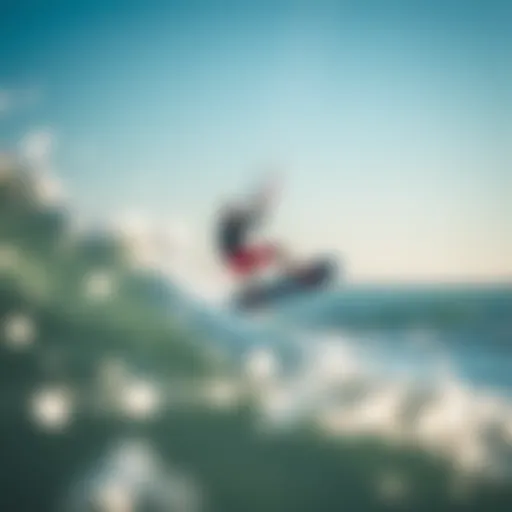Crystal River Marine Forecast: Essential Tips for Kiteboarding
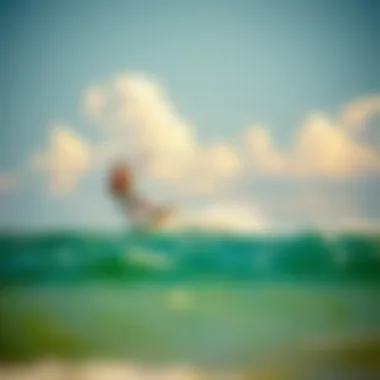

Intro
Kiteboarding is more than just a sport; it’s a dance with the wind and water. For enthusiasts flocking to the picturesque Crystal River, understanding the marine forecast is essential. The region’s unique geography, combined with dynamic weather patterns, creates a playground—or a potential hazard—depending on the day. This article delves into pivotal aspects of the marine forecast that kiteboarders should heed. From wind conditions to tidal influences, we will arm you with key insights that not only enhance your success on the water but also prioritize your safety.
As we navigate through this guide, kiteboarding novices and veterans alike will gain valuable knowledge that can elevate their experience on the stunning waters of Crystal River. When it comes down to it, knowing the conditions is half the battle; the other half is honing the techniques that make each ride exhilarating.
Techniques for Kiteboarding Enthusiasts
Understanding how to effectively maneuver your board and kite can make all the difference in your performance on the water. Here’s a breakdown of techniques suitable for both newcomers and seasoned riders.
Beginner Techniques
Starting off with the basics allows the aspiring kiteboarder to build a solid foundation. Here are some key procedures for beginners:
- Kite Setup: Familiarize yourself with your kite’s components. Know how to set up the lines and check for any wear or damages.
- Body Dragging: Before hitting the board, practice body dragging. This technique develops your comfort level with the kite in the water and helps you understand how to control it effectively.
- Water Start: Begin with getting the kite in the right position and utilizing your body weight to pop you up. Timing with the wave is important here; patience makes perfect.
- Riding Direction: Once you are up on your board, finding your direction is crucial. Always look ahead and keep your weight balanced.
Advanced Maneuvers
For those who have mastered the basics, it’s time to explore advanced techniques:
- Jumping: Start small; feel the timing of the kite pressuring up, and pop off the water. Focus on bending your knees upon landing.
- Board Off Tricks: Take your foot out of the strap on jumps and balance your kite to execute impressive tricks.
- Kiteloops: These powerful moves require precision and control. Ensure you practice in optimal wind conditions as they can pack a punch!
- Transitions: Seamlessly changing directions while riding can maintain momentum in the waves. Master your speed and balance to execute smooth turns.
“The sea is the stage, the kite is your partner, and every gust tells a new story.”
The End
This guide covers essential techniques for kiteboarding enthusiasts, ranging from basic skills to thrilling maneuvers that elevate your performance. With these tools in your kit, you’ll be better prepared to tackle the Crystal River’s waters, leveraging its marine conditions to your advantage. Remember, practicing in a safe environment and fostering awareness of your surroundings is key to enjoying this exhilarating sport. As we proceed, we’ll explore equipment reviews and marine forecasts tailored to kiteboarders, ensuring your outings are met with success and enjoyment. Be sure to stay tuned!
Overview of Crystal River
Crystal River, situated in Florida's Nature Coast, serves as a captivating backdrop for water enthusiasts, particularly kiteboarders. With its unique blend of favorable environmental conditions, the area has become a hotspot for those looking to glide over the waves. The geographical elements, such as the diverse coastline and the mixing of freshwater and saltwater from nearby springs, play an intricate role in shaping the experience for water sports.
Geographical Context
The geography of Crystal River is nothing short of remarkable. Located on the Gulf Coast, the river flows into the Gulf of Mexico, creating an ideal setting for various water activities. The surrounding landscape features lush greenery with cypress trees dotting the waterfront, providing a picturesque view as you prepare to hit the water.
Kiteboarders benefit from the unique geography, where inland springs and tidal influences affect water conditions. These natural elements foster a dynamic environment for both seasoned and novice kiteboarders. Flatwater spots near the river mouth contrast sharply with the open Gulf waters, allowing kiteboarders a chance to choose their preferred riding style. Beaches such as Fort Island Beach attract local and visiting kiteboarders alike, making it a gathering point for enthusiasts.
Significance for Water Sports
Crystal River's reputation in the water sports community isn't just a stroke of luck; it's built on several advantages. Foremost, the favorable wind patterns prevalent in the area provide kiteboarders with the steady breeze essential for elevating their skills and enjoying their time on the water. The ideal conditions allow for extended sessions, whether you’re looking to fine-tune your jumps or simply cruise along the surface.
Moreover, the safety of the area cannot be overlooked. The expansive space available for kiteboarding means that riders can find their places without being too crowded. This is particularly important for instructors and coaches who might be running lessons.
In addition, the local community takes pride in preserving its marine environment. Far from being a mere playground, Crystal River offers a chance to appreciate and respect the ecosystem, be it through observing dolphins or spotting the famed manatees. By keeping an eye on the natural world while kiteboarding, enthusiasts can engage in an activity that’s not only fun but also promotes environmental awareness.
Forecast Fundamentals
Understanding the fundamentals of marine forecasts is essential for kiteboarding enthusiasts. This section will shed light on the core elements that influence kiteboarding conditions in Crystal River. Knowing how forecasts work empowers riders to make informed decisions, ensuring not just a thrilling experience but also a safe one.
Understanding Marine Forecasts
Marine forecasts serve as a lighthouse in the choppy waters, guiding kiteboarders through the unpredictability of wind and weather. They provide a detailed outlook, focusing on factors like wind patterns, tides, and atmospheric conditions that directly affect kiteboarding. For any water sports enthusiast, well-informed choices can turn an average session into a fantastic one. Whether you are a novice learning to navigate or a seasoned pro hunting for the perfect wind, getting familiar with marine forecasts is key.
It's like trying to fish without knowing where the schools are – it'll be a long day with little catch.
Key Components of Forecasts
The key components of marine forecasts allow kiteboarders to strategize their outings effectively. Understanding these components is akin to knowing the lay of the land before setting off on a journey. Let’s delve deeper into the specific aspects of marine forecasts that play substantial roles.
Wind Speed and Direction
Wind is the lifeblood of kiteboarding; it fuels the ride. The wind speed and direction will largely dictate the experience on the water. Wind speed, generally measured in knots, affects how much lift a rider can achieve. On the other hand, wind direction is crucial for understanding where to launch and land.
- Key Characteristics:
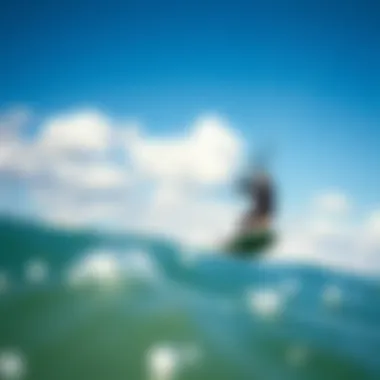

- Speed: A higher wind speed means increased potential for tricks and jumps.
- Direction: Side-on shore winds are often considered the most favorable for kiteboarding as they provide a smoother ride with less risk of crashing into the shoreline.
Wind direction can sometimes make or break a session, especially in areas like Crystal River where obstacles such as trees and buildings can create turbulence. Riders need to be aware of the unique features that accompany different wind directions. Sometimes, an offshore breeze sounds appealing, but in reality, it can push riders away from the shore, posing a significant risk.
Tidal Movements
Tides are another player in the kiteboarding game. Tidal movements can change the landscape of the water, affecting how and when kiteboarders go out. High tide can create inviting, deep waters that's great for jumping, while low tide can expose sandbars or create detrimental conditions.
- Key Characteristics:
- High Tide: Often leads to smoother water conditions, enhancing performance.
- Low Tide: Can be tricky, with shallow areas presenting hazards for equipment and limbs.
Being aware of tidal patterns helps kiteboarders select optimal times for their sessions, minimizing risks while maximizing fun. Pick the wrong timing, and you might end up stranded or racing against the current.
Wave Heights
Waves can elevate or destroy a kiteboarding experience. Understanding wave heights is critical, especially in more dynamic conditions often seen in coastal regions. Riders may seek out waves for an adrenaline rush, but excessive heights can quickly deter safety.
- Key Characteristics:
- Moderate Wave Heights: Can invigorate the ride, making for exciting jumps.
- Extreme Heights: Potentially hazardous, leading to equipment damage or severe crashes.
Being proactive about wave heights means a better grasp of one’s limits, keeping the experience thrilling yet safe.
When the waves start to rise, smart riders check their gear and approach with caution. They know that while a challenge can be fun, safety always comes first.
The components discussed hold significant sway over whether a kiteboarding session is successful or a lesson in patience. By keeping close tabs on these factors, riders can gain an edge, boosting their overall enjoyment and safety while on the water.
Remember: Knowledge of marine forecasts and their components isn't just about planning - it's about respecting the ocean's power.
Wind Patterns in Crystal River
Understanding the wind patterns in Crystal River is critical for kiteboarding enthusiasts. Kiteboarding hinges largely on wind, and knowing how it shifts and changes can make or break a session on the water. These patterns dictate not only the type of gear you'll need but also the overall plan for your kiteboarding excursion. Wind influences can turn a decent day into an excellent one or vice versa, and that's why delving into seasonal variations, as well as the optimal conditions for kiteboarding, is essential.
Seasonal Variability
Summer Winds
Summer winds come with their own set of characteristics that cater to kiteboarding. Generally, these winds are consistent and tend to blow from the southeast. During the summer months, which draw many enthusiasts to the waters, wind speeds usually range from 10 to 20 knots. This predictability makes summer an ideal season for both novice and seasoned kiteboarders. The warmth of the sun adds to the pleasurable experience, and you can ride without the chill that sometimes comes with other seasons. However, it’s crucial to consider that these winds can also be gusty, leading to unexpected challenges. Maximizing the advantage of summer winds requires careful attention to changing conditions for safety and enjoyment.
Winter Winds
When winter rolls around, the dynamics shift. Winds often pick up from the northwest to northeast, bringing cooler air and different challenges. The key characteristic of winter winds is their strength. Speeds can often reach 15 to 30 knots, presenting an exciting, fast-paced environment for those with more experience. These winds, while powerful, can also be unpredictable, causing sudden shifts that can catch even seasoned riders off guard. While the scenery can be stunning with fewer crowds, riders must be cautious as the chill factor is significant during these months, and it's vital to be prepared for such conditions.
Optimal Conditions for Kiteboarding
The optimal conditions for kiteboarding hinge on a few factors that every enthusiast should keep their eyes on. Firstly, steady winds are the obvious must-have; fluctuations can lead to less enjoyable riding.
Optimal conditions typically feature wind speeds within the range of 12 to 25 knots, as this allows for maneuverability without being overwhelmingly difficult to manage. The kite size also increases the chance of a good session, as wanting to use a smaller kite during high winds can bring difficulties. Wave height can affect the ride experience as well; ideally, moderate wave heights provide an exhilarating yet manageable experience.
Additionally, kiteboarders should always keep in mind the tides since they can significantly change the conditions based on the area you are riding in. With thorough preparation and attention to these conditions, adventurers can find a rhythm that suits not just their skill levels but also allows them to enjoy all that Crystal River has to offer.
Always stay updated with the latest forecasts on conditions to ensure both safety and enjoyment while kiteboarding!
For accurate wind conditions and monitoring, platforms like Windy.com and Kiteboarder Magazine provide valuable insights into wind patterns and tides, helping kiteboarders plan every adventure with precision.
Tides and Their Effect on Kiteboarding
Understanding tides is vital for kiteboarding enthusiasts, especially in locations like Crystal River, where the interplay between wind and water can significantly impact one's experience on the water. Tides not only affect the water level but also create various riding conditions that can either enhance or hinder your kiteboarding session. Grasping the nuances of high and low tides can be the difference between a thrilling ride or a rather uneventful day.
High and Low Tides
In a nutshell, tides in Crystal River are influenced by the gravitational forces exerted by the moon and the sun. This influence causes predictable rises and falls in water levels at regular intervals, manifesting as high and low tides.
During high tide, the water level rises, which may allow for greater maneuverability and area for kiteboarding, particularly near shore. However, this can also lead to stronger currents. In contrast, low tide exposes more of the seabed, providing some kiteboarders with an opportunity to practice tricks that require less water. It’s essential to consider that each of these tidal states affects not just the riding experience but also the safety precautions you should take when heading out.
There are times when the current can get quite swift, especially during high tide. Understanding this can help you adjust your strategies accordingly. For instance:
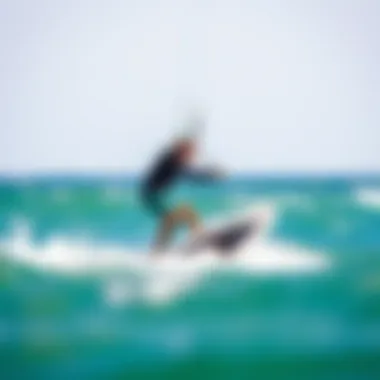

- Plan for safety: Keep an eye on your distance from the shore to avoid getting swept away by stronger currents.
- Utilize the terrain: Low tides can reveal sandbars and other features that you can use to practice your turns or jumps.
Timing Your Session
The timing of your kiteboarding session in relation to the tides is crucial. Ideally, you'll want to aim for those moments when tides are meeting favorable wind conditions.
- Consult a Tidal Chart: Before you set out, checking a tidal chart can help you predict when high or low tides will occur. Knowing these times can guide you in choosing the perfect window for your session. If you're in a hurry, you might not consider this, but it's an essential piece of information.
- Adjust Based on Conditions: Sometimes, the tides and wind don’t cooperate. If high tide coincides with high winds, it may create choppy waters, which might not be ideal for beginners. Conversely, low tide with strong winds can yield a faster ride, perfect for those looking to catch some air.
- Be Vigilant After Launch: It’s wise to monitor how the tide is changing during your session. Water levels can subtly shift, and losing track of this can lead to unanticipated hazards.
Remember, every session in Crystal River is unique, driven by the interplay between tides, wind, and your own skill level. Keeping an eye on tidal movements will not only enhance your experience but also ensure you're respecting the local environment and its wildlife, allowing for a safer and more enjoyable kiteboarding adventure.
Important Note: Always prioritize your safety and prepare in advance. The ocean doesn’t play favorites, and it’s best to be equipped with knowledge and awareness no matter your experience level.
Resources for Further Reading
Weather Conditions to Monitor
Understanding the weather is an essential part of kiteboarding in Crystal River. Kiteboarders must be aware of and monitor various weather conditions that can significantly impact their performance and safety on the water. Here, we'll delve into sky conditions and precipitation impact—two crucial elements that can make or break a kiteboarding adventure.
Sky Conditions
When you’re planning a kiteboarding session, the sky can tell you a lot. Clear skies often signal good riding conditions, ensuring you have that reliable sunlight illuminating your path. However, a sky that’s overcast might suggest brewing clouds, which can affect wind patterns and visibility. Kiteboarders should regularly check for cloud types—cumulus clouds generally indicate fair weather, but dark, towering cumulonimbus clouds often spell trouble, bringing strong winds or storms.
Factors to note about sky conditions include:
- Visibility: A clear view is vital for spotting potential hazards like other watercraft or swimmers.
- Wind Turbulence: Dark skies can indicate turbulent air, affecting how the kite flies. Flat, even clouds usually mean stable winds, while those fluffy, waving clouds could create tricky gusts.
It's best to check weather apps or websites that provide real-time satellite imagery. Getting a sense of aerial shifts can help in making informed decisions about hitting the water or staying on land.
Precipitation Impact
Rain can be a mixed bag for kiteboarders. Light drizzle may not hinder your fun too much, but heavy rain could create hazardous conditions on the water. Wet conditions can affect your grip on the board and decrease visibility, which can be dangerous, especially in crowded areas.
Consider these points when it comes to rain and kiteboarding:
- Water Refraction: Heavy rain adds more texture to the water surface, affecting how your kite interacts with the breeze. This can lead to unpredictability in wind flow, which is something every kiteboarder needs to watch.
- Wind Shifts: Rain often causes abrupt changes in wind speed and direction. If you see dark clouds, expect gusty winds to follow.
- Lightning Safety: One major reason to keep an eye on the skies is safety. Keep far away from the water when there's lightning in the area. It’s not just a suggestion; it's a rule of thumb you should never ignore.
Ultimately, making informed choices based on both sky conditions and precipitation can elevate your kiteboarding experience. Remember, when ridding the waves, the more you know, the safer you are. For updated forecasts, check out these reliable resources: National Weather Service, Weather.com, and Windy.com.
Local Wildlife Considerations
When kiteboarding in Crystal River, a keen understanding of local wildlife can significantly enhance both safety and enjoyment on the water. The region is teeming with marine life, which adds a layer of beauty but also requires us to approach our activities with care. This section delves into two main aspects: marine life awareness and conservation practices, emphasizing the importance of harmonizing our sports with local ecosystems.
Marine Life Awareness
Kiteboarders should stay vigilant regarding the diverse marine creatures in the waters of Crystal River. The estuarine environment is a sanctuary for several species, including manatees, dolphins, and various types of fish. Understanding and recognizing these creatures is crucial. For instance, manatees are often spotted near the surface, basking in the sun or grazing on seagrass. They are protected by law, meaning that harming them either accidentally or intentionally can have serious consequences.
Other wildlife, such as jellyfish, also present a potential hazard. Many kiteboarders have experienced unwanted stings while navigating through these waters. Getting familiar with the local marine species can prepare you to avoid danger while benefiting from the stunning scenery. Always remember to:
- Keep an eye out for any wildlife signs posted in the area.
- Watch for behavior indicative of marine animals, like unusual surface disturbances or changes in water clarity.
- Report any sighting of distressed wildlife to the local authorities.
Conservation Practices
As kiteboarders, we have a responsibility to protect the marine environment while enjoying the thrill of the sport. Implementing sustainable practices can make a difference in conserving Crystal River’s physical and biological integrity. Here are some essential practices:
- Respecting No-Wake Zones: Many areas around the river are designated as no-wake zones to safeguard fragile ecosystems. Adhering to these regulations helps reduce water turbulence which can harm nesting areas and habitats.
- Avoiding Littering: It might seem basic, but disposing of trash properly is vital for preserving the beauty and health of this natural habitat. Bring a bag to collect any waste, and if you spot litter while on the water, do your part by removing it.
- Participating in Local Clean-up Events: Engaging in community initiatives to clean the waterways helps foster goodwill while preserving the environment you enjoy. Keeping a lookout for these events is a great way to meet other enthusiasts and make a positive impact.
"Keeping Crystal River’s ecosystems healthy ensures that generations of kiteboarders can experience its beauty in the future."
For those passionate about kiteboarding and the environment, combining the two is both exhilarating and imperative. The relationship between kiteboarding enthusiasts and local wildlife is one of coexistence. By staying informed and practicing conservation, we can navigate the waters with both joy and respect for the remarkable creatures dwelling beneath the surface.
Equipment Check for Kiteboarding
Kiteboarding is akin to a dance with nature, where every movement depends heavily on the equipment you wield. Ensuring your gear is not only suited for the day’s conditions but also well-maintained can make the difference between a thrilling ride and a misadventure. Let’s delve into the critical aspects to consider when checking your gear for a kiteboarding session on Crystal River.
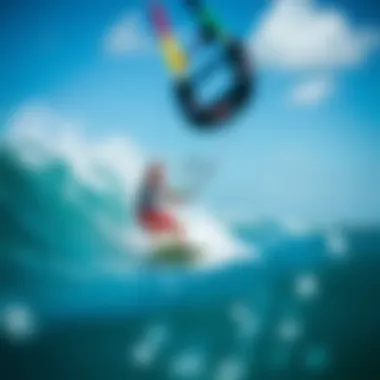

Wind-specific Gear Selection
The heart of kiteboarding lies in wind conditions, making wind-specific gear selection paramount. If you find yourself underestimating wind strength or the nuances of its direction, your experience could swing from exhilarating to daunting in seconds. Here’s a breakdown of vital components tailored for the varying conditions of Crystal River:
- Kite Size:
- Board Type:
- Control Bar:
- In light winds, larger kites like a 12 or 14-meter will carry you smoothly across the water.
- Conversely, in high winds, a smaller kite around 7 or 9 meters provides the control needed to avoid being overpowered.
- Freestyle boards deliver optimal performance for tricks but may struggle in choppy conditions.
- For big winds, a directional board can enhance stability and edge control.
- Ensure your control bar is compatible with your kite, with adjustable lengths to suit your preferences. A longer bar can be more responsive in turbulent conditions.
Choosing the right equipment isn’t just about liking a color or brand. Think of it like choosing the right tool for a job—using a hammer when a screwdriver is required won’t get the task done efficiently.
Safety Equipment Essentials
Safety isn’t just a box we tick off; it’s a mindset that permeates every kiteboarding session. The right safety gear protects you from unforeseen circumstances on the water. Here are essentials every kiteboarder should have in their quiver:
- Personal Flotation Device (PFD): It’s not just a legal requirement but a lifesaver. A well-fitted PFD increases your buoyancy and visibility in potentially risky scenarios. Opt for a style that allows for mobility and comfort.
- Helmet: While it may not be the trendiest accessory, protecting your noggin is crucial. Whether it's a sudden fall or a stray board coming your way, a helmet serves as your first line of defense.
- Safety Leash: This piece of equipment connects you to your kite, allowing immediate release if the situation turns south. It’s the kind of gear you don’t consider until you actually need it, and by then, it’s too late.
- Impact Vest: For those who love to push boundaries with tricks or jumps, having an impact vest can be a game changer. It cushions your body against hard landings, reducing the chance of injury.
In kiteboarding, knowing how to check your equipment isn’t just a practice; it’s an art. Ensuring that every element from kites to leashes is in optimal condition fosters confidence and preparedness, allowing you to focus entirely on the glorious experience ahead.
"Preparation is the key to success. A well-prepped kiteboarder arrives at the water confident and ready."
Being diligent about equipment checks before you hit the water lets you revel in the joy of kiteboarding while staying clear of mishaps, so make that checklist comprehensive.
Tips for Safe Kiteboarding
Kiteboarding in Crystal River is a thrilling experience; however, it's crucial to prioritize safety. As kiteboarders navigate the waters, understanding how to ensure a safe session can make the difference between a great day and a hazardous one. The unpredictable nature of wind and water conditions requires kiteboarders to be well-prepared and mindful.
Understanding your Limits
Every kiteboarder, regardless of skill level, must have a clear understanding of their physical abilities and technical skills. This self-awareness can prevent accidents. It’s like knowing how fast you can run before challenging yourself to a sprint; pushing too hard can lead to injuries.
- Assess Your Skill Level: If you're still mastering the basics, don't shy away from sticking to flat water spots with steady winds. Advanced maneuvers should wait until you feel fully confident.
- Know Your Equipment: Familiarize yourself with your gear. If you’re using a new kite or board, spend some time just getting feel for it on land before hitting the waves.
- Listen to Your Body: Fatigue is often the enemy of safety. If you're feeling worn out, it’s best to call it a day rather than pushing your limits. Don’t be too proud to walk away when you're not at your best.
Understanding these limits isn't just about physical stamina. It’s also about the mental aspect; kiteboarding should be fun, not stressful. If the conditions don’t feel right, it’s okay to sit it out for another day.
Navigating Challenges
Even at the best of times, challenges can arise while kiteboarding. From shifting winds to changing tides, being prepared to respond is key to maintaining a safe environment.
- Stay Aware of Your Surroundings: Kiteboarding often brings you close to other water users - swimmers, paddleboards, and other kiteboarders. Respect space to avoid collisions. Maintain a safe distance and keep an eye out for any hazards.
- Be Ready for Weather Changes: Weather can change faster than you can think. Always check local forecasts, but also be attentive to the sky above you when on the water. Dark clouds or a sudden drop in temperature might mean it’s time to head back.
- Communicate with Others: If you're out with friends or other kiteboarders, establish clear signals for potential hazards or emergencies. Keeping lines of communication open can save lives.
Remember: Kiteboarding should always be enjoyed safely. Navigating challenges is part of the experience, but staying informed and prepared makes it all the more rewarding.
By incorporating these safety tips into your routine, you'll enhance not only your proficiency but also the pleasure found in the sport.
Resources for Updated Forecasts
Keeping up with the marine conditions in Crystal River is vital for kiteboarding enthusiasts. Weather isn’t just a convenience; it’s a game changer. An accurate and up-to-date forecast allows kiteboarders to plan their adventures, ensuring safety and maximizing fun on the water. A good setup can be the difference between a fantastic day soaring through the air and one spent wrestling with unfavorable conditions.
Reliable Weather Services
To stay ahead of changing conditions, kiteboarders must rely on weather services that specialize in marine forecasts. Traditional weather reports often lack the specificity needed for water sports. Here are some recommended sources:
- NOAA (National Oceanic and Atmospheric Administration): This government agency provides real-time weather updates specifically tailored to coastal conditions. It's a gold mine for anyone needing accurate data on wind, tides, and storms. Always monitor NOAA's marine forecast for local updates on conditions before heading out.
- National Weather Service: Another government entity, the NWS offers updated forecasts that are invaluable for understanding broader weather patterns influencing kiteboarding in Crystal River.
- AccuWeather: Known for its user-friendly interface, AccuWeather offers reliable hourly forecasts, which can be especially helpful. Look for sections focused on wind speed and direction, essential factors for kiteboarding.
- Windy.com: This site offers interactive maps showing wind patterns and sea conditions, helping kiteboarders visualize the best time to hit the water.
Just as you wouldn’t go into battle without a plan, knowing where to find reliable marine forecasts helps kiteboarders avoid hazardous conditions. Consider checking multiple sources to verify weather changes, as each service might interpret data slightly differently.
Mobile Apps and Tools
Having the right tools right at your fingertips makes life easier, especially on a windy day. Mobile apps dedicated to weather forecasting can be lifelines for kiteboarders. Here’s a breakdown of useful apps:
- Kite Predictor: This app uses GPS data to provide kiteboarders with personalized forecasts based on your location. Users can explore different spots and see what wind conditions are expected at each.
- Windy: The app version of Windy.com gives you access to the same detailed maps in a mobile-friendly format. You can check wind patterns, waves, and even visualize satellite imagery. It’s an indispensable companion when planning your kiteboarding adventure.
- WeatherBug: This app provides comprehensive weather information, including alerts for storm conditions. It helps you keep a close eye on sudden changes that could impact your plans.
- MyRadar: This radar app offers real-time weather updates and storm tracking. A must-have for those with an eye on safety and precautions.
Incorporating these tools into your routine doesn’t just prepare you for a good day on the water; it boosts your confidence. A kiteboarder informed about the weather is a kiteboarder ready to seize the day.
"Safety first is safety always!"
Adaptability in kiteboarding comes from being aware of conditions – don’t risk it by skipping updates.
By utilizing reliable weather services and mobile applications, kiteboarding enthusiasts can navigate the waters of Crystal River with assurance, tailoring their experiences to the best possible conditions. So gear up, check your forecasts, and get ready to fly!





